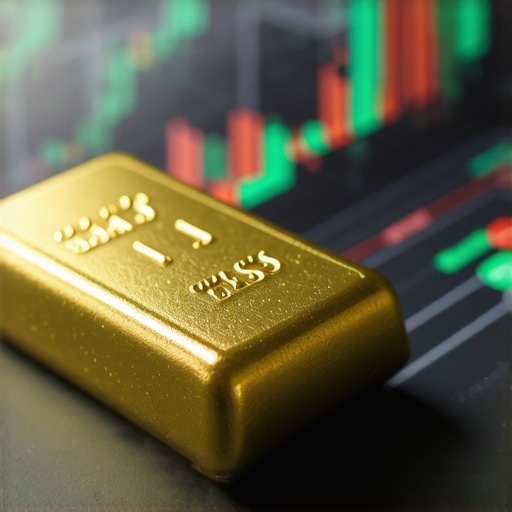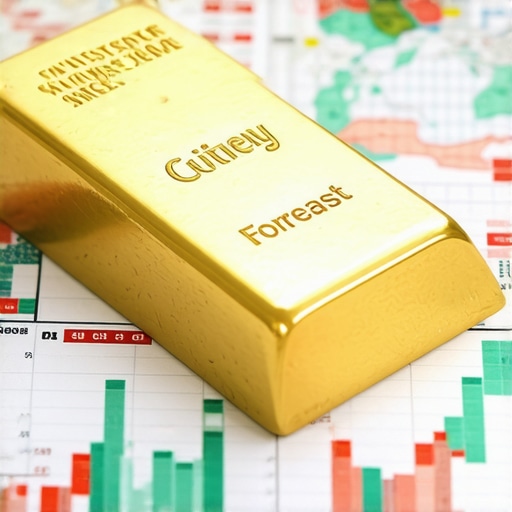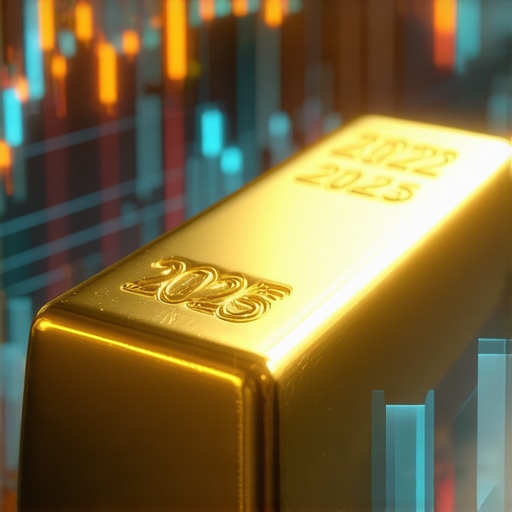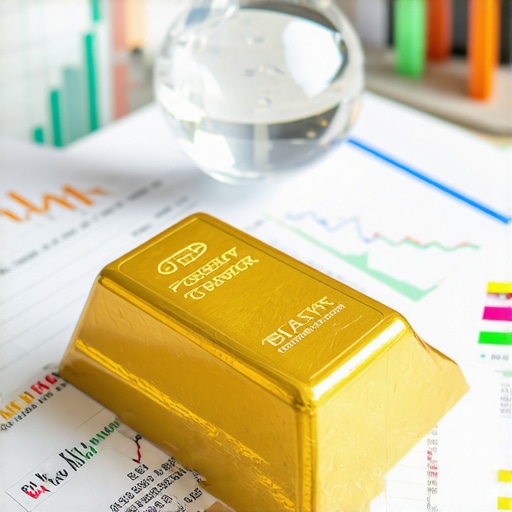Unraveling the 2025 Gold Price Forecasts: A Deep Dive into Market Dynamics
As financial markets continue to grapple with unprecedented volatility, the outlook for gold prices in 2025 remains a focal point for investors, analysts, and policymakers alike. This article synthesizes expert predictions, macroeconomic trends, and geopolitical influences to offer a comprehensive understanding of the anticipated trajectory of gold prices over the coming year. Drawing upon advanced market analysis and authoritative sources, we aim to equip sophisticated investors with nuanced insights into the evolving landscape of gold valuation.
Deciphering the Key Drivers of Gold Price Movements in 2025
How will global macroeconomic factors shape gold’s trajectory in 2025?
Forecasts indicate that inflationary pressures, monetary policy shifts, and currency fluctuations will significantly influence gold prices. Experts from institutions like the World Gold Council suggest that persistent inflation and central bank policies favoring quantitative easing could propel gold to new heights, serving as a hedge against fiat currency devaluation (market analysis on demand drivers).
What role will geopolitical tensions play in gold’s demand elasticity?
Geopolitical uncertainties, including regional conflicts and trade tensions, tend to elevate gold’s status as a safe-haven asset. Analysts project that heightened geopolitical risks in 2025 could amplify gold’s appeal, especially amid potential disruptions in global supply chains and financial markets.
The Influence of Central Bank Policies and Gold Reserve Accumulation
Central banks worldwide are expected to continue diversifying their reserves, with many increasing gold holdings. This sustained accumulation, as detailed in recent central bank purchase reports, could underpin upward pressure on prices, reflecting strategic shifts in reserve management and monetary policy adjustments.
Expert Predictions and Analytical Models for 2025
Market forecasts from top financial institutions and commodity analysts converge on a median gold price range of $2,100 to $2,300 per ounce by the end of 2025. These projections incorporate complex models accounting for supply-demand imbalances, technological advancements in mining, and macro-financial trends. Notably, some models highlight the potential for price surges exceeding $2,400, contingent on unforeseen geopolitical or economic shocks.
How Should Investors Strategically Position Themselves for 2025?
Given the nuanced outlook, seasoned investors are advised to diversify their portfolios with physical gold investments and gold-backed ETFs, leveraging expert strategies detailed here. Maintaining a balanced exposure, coupled with vigilant market monitoring, can optimize long-term wealth preservation amid volatility. Additionally, understanding the intricacies of gold futures and options can unlock tactical advantages in navigating short-term fluctuations.
What are the emerging risks and uncertainties that could disrupt gold’s forecasted trajectory?
Potential disruptions include sudden shifts in monetary policy, changes in global trade agreements, or breakthroughs in alternative investment technologies. Staying informed through authoritative analyses and ongoing market intelligence remains essential for adaptive investment strategies.
To deepen your expertise on gold market dynamics, consider exploring comprehensive market analyses and engaging with industry professionals for strategic insights. The evolving nature of global economic conditions underscores the importance of a vigilant, research-driven approach to gold investing in 2025.
How Can Advanced Gold Investment Strategies Outperform Traditional Approaches in 2025?
As the gold market becomes increasingly complex amid evolving macroeconomic and geopolitical landscapes, sophisticated investors are exploring nuanced strategies to optimize their holdings. The integration of derivative instruments such as gold options and futures, alongside innovative portfolio diversification techniques, can offer tactical advantages. For instance, leveraging futures technical analysis allows traders to anticipate short-term price movements and hedge against volatility, thereby enhancing overall portfolio resilience.
Are there emerging tools or frameworks that can give investors a competitive edge in navigating 2025’s gold markets?
Emerging analytical tools, including machine learning models and real-time market sentiment analysis, are becoming vital for deciphering complex market signals. These tools help in developing predictive insights based on multifactor data, encompassing supply-demand imbalances, central bank activities, and macroeconomic indicators. According to industry experts, employing such advanced frameworks can significantly improve decision-making accuracy, especially during periods of heightened market turbulence (market analysis techniques).
How Do External Events and Technological Advances Shape Gold’s Future in 2025?
Global technological progress, particularly in blockchain and digital assets, poses both challenges and opportunities for gold investors. While some speculate about a potential decline in physical gold demand due to digital alternatives, others argue that innovations like blockchain-backed gold tokens could provide liquidity and transparency, attracting new investor segments. Furthermore, external events such as climate change initiatives and resource scarcity could influence mining activities, supply levels, and ultimately, gold prices. Staying informed through comprehensive resources like market analysis reports is crucial for adapting strategies accordingly.
What role will geopolitical and economic shocks play in redefining gold’s safe-haven status in 2025?
Unpredictable geopolitical conflicts or economic crises can rapidly shift investor sentiment, prompting sudden surges in gold demand. Experts emphasize the importance of maintaining flexible investment strategies that can swiftly respond to such shocks, including allocating a portion of assets to physical gold, which remains a resilient hedge. For a detailed approach on constructing such resilient portfolios, explore gold IRA strategies.
Share your insights or questions about evolving gold strategies for 2025—engaging in community discussions can uncover valuable perspectives and actionable ideas. To deepen your knowledge, consider reading comprehensive market forecasts and expert analyses tailored for forward-thinking investors.
Harnessing Cutting-Edge Analytical Frameworks to Optimize Gold Portfolios in 2025
In the rapidly evolving landscape of precious metals investment, leveraging sophisticated analytical tools is no longer optional but essential. Advanced machine learning models, combined with real-time sentiment analysis, empower investors to anticipate market shifts with unprecedented precision. For instance, predictive algorithms trained on multifactor data—such as macroeconomic indicators, geopolitical developments, and supply-demand metrics—can identify emerging trends before they become apparent to traditional analysis methods. According to a recent report by the World Gold Council, integrating AI-driven insights into investment strategies can enhance portfolio resilience, especially during periods of heightened volatility.
What are the practical steps to incorporate AI and machine learning into gold investment decision-making?
Firstly, investors should collaborate with data scientists or employ specialized platforms that offer predictive analytics tailored for commodities markets. Secondly, continuous data feed integration ensures models adapt dynamically to new information—be it macroeconomic reports, central bank disclosures, or geopolitical events. Lastly, rigorous backtesting and scenario analysis validate the robustness of these models, enabling traders to refine their strategies proactively. As the industry advances, adopting such frameworks can provide a distinct competitive edge in navigating complex market environments.
Innovative Derivative Strategies to Hedge Against Price Volatility in 2025
Beyond physical gold and ETFs, sophisticated investors are increasingly turning to derivative instruments like options and futures to hedge and speculate strategically. For example, employing gold options with tailored strike prices and expiration dates allows traders to lock in potential gains or limit losses amid unpredictable price swings. Furthermore, structured products combining options and other derivatives can offer customized exposure aligned with specific risk appetites and market outlooks. According to CME Group’s comprehensive guide, mastering these instruments requires a nuanced understanding of implied volatility, delta hedging, and margin requirements—skills that distinguish seasoned traders from novices.
How can investors effectively deploy options strategies to capitalize on anticipated market movements?
Strategic deployment involves scenario planning—identifying potential catalysts like geopolitical tensions or monetary policy shifts—and selecting appropriate options strategies such as straddles, spreads, or protective puts. For example, a bull call spread can profit from moderate upward price movements, while protective puts serve as insurance against sudden downturns. Educating oneself on the Greeks—delta, gamma, theta, and vega—can significantly improve the precision of these strategies. Engaging with experienced derivatives traders or utilizing advanced trading platforms can further optimize outcomes in dynamic market conditions.
The Role of ESG and Sustainability Factors in Shaping Gold Market Dynamics in 2025
Environmental, Social, and Governance (ESG) considerations are increasingly influencing investor preferences and regulatory frameworks. The push for sustainable mining practices and transparent supply chains is reshaping the industry. According to a detailed report by Mining.com, companies adopting eco-friendly technologies and adhering to strict ESG standards tend to attract institutional investment and enjoy premium valuations. Moreover, the integration of blockchain technology facilitates traceability, ensuring that gold sourced meets sustainability benchmarks—an evolving trend that can impact supply dynamics and, consequently, prices.
What strategic advantages can investors gain by integrating ESG criteria into their gold investment approach?
Incorporating ESG factors can mitigate risks associated with regulatory penalties, reputation damage, and supply chain disruptions. By focusing on ethically mined gold, investors align their portfolios with global sustainability goals, potentially unlocking access to a broader pool of capital. Furthermore, ESG-compliant assets often demonstrate lower volatility and better long-term performance, especially as regulatory environments tighten and consumer preferences shift toward responsible sourcing. Engaging with ESG-focused funds or directly assessing mining operations’ sustainability credentials becomes crucial for forward-looking investors.
To deepen your understanding of these advanced strategies and stay ahead in the competitive gold market of 2025, explore authoritative resources such as industry reports, academic journals, and expert webinars. The future of gold investment hinges on innovative approaches, rigorous analysis, and a proactive mindset—embrace these principles to maximize your strategic edge.
Harnessing Cutting-Edge Technologies to Revolutionize Gold Investment in 2025
As the gold market evolves amidst rapid technological advancements, investors must leverage innovative analytical frameworks such as quantum computing algorithms and big data analytics. These tools facilitate the processing of vast datasets—including geopolitical trends, macroeconomic indicators, and supply chain dynamics—enabling predictive precision that surpasses traditional methods. Industry leaders from institutions like the World Gold Council emphasize that integrating such high-performance computing can significantly enhance decision-making accuracy, especially during periods of heightened volatility.
How Can Quantum Computing and Big Data Shape Gold Market Predictions in 2025?
By harnessing quantum algorithms, analysts can simulate complex market scenarios and identify subtle correlations within multifactor datasets. This capability allows for the anticipation of price shifts driven by geopolitical upheavals or macroeconomic shocks before they manifest visibly. The fusion of these technologies with machine learning models creates a dynamic, adaptive analytical environment where real-time insights provide a strategic edge.
What are the practical steps for investors to incorporate quantum analytics into their gold portfolio management?
Investors should collaborate with data science specialists or utilize platforms equipped with quantum simulation tools. Continuous data stream integration ensures models remain current, while backtesting across diverse scenarios refines predictive reliability. Adopting such advanced systems enables proactive positioning, transforming reactive trading into strategic foresight.
Emerging ESG Technologies and Their Impact on Gold Supply Chains in 2025
The integration of blockchain-based traceability platforms and AI-driven ESG compliance tools is reshaping the gold supply landscape. These innovations promote transparency, ensuring ethically sourced gold aligns with stricter regulatory standards and consumer expectations. As detailed in the Mining.com report, companies adopting these technologies benefit from enhanced reputation and access to ESG-focused capital, which can influence supply availability and pricing dynamics.
How Will Digital Asset Tokenization Affect Gold Liquidity and Market Accessibility?
Tokenization of gold through blockchain platforms creates liquidity bridges, enabling fractional ownership and 24/7 trading. This democratization broadens investor access, especially for retail segments previously constrained by high entry barriers. Moreover, digital gold tokens can provide real-time settlement and provenance verification, reducing counterparty risk and fostering a more resilient market ecosystem. Industry experts suggest that such innovations will be pivotal in attracting new capital flows and stabilizing prices amidst macroeconomic fluctuations.
What strategic considerations should sophisticated investors evaluate when integrating digital gold tokens into their portfolios?
Investors should scrutinize the custody protocols, platform transparency, and regulatory compliance of token issuers. Diversification should include a blend of physical gold, ETFs, and digital tokens, balanced against risk appetite and liquidity needs. Staying informed on technological developments and regulatory evolutions is essential to capitalize on these emerging opportunities while mitigating potential vulnerabilities.
Incorporating Geopolitical Risk Models and Scenario Planning for 2025
Advanced geopolitical risk modeling, utilizing real-time open-source intelligence and scenario simulation, empowers investors to prepare for sudden market shocks. Integrating these models with financial analytics allows for dynamic hedging strategies—such as options and structured products—that adapt swiftly to unfolding events. As geopolitical tensions persist globally, maintaining a flexible, data-driven approach becomes critical for safeguarding assets and unlocking strategic gains.
How can investors develop a resilient, adaptive gold investment framework amid geopolitical uncertainties?
Constructing a resilient framework involves diversifying holdings across physical assets, derivatives, and emerging digital instruments, all informed by real-time risk analytics. Regular stress testing and scenario analysis ensure preparedness for various shock scenarios, while active monitoring of geopolitical developments enables timely adjustments. Engaging with multidisciplinary experts—ranging from geopolitical analysts to quantitative modelers—can significantly enhance strategic robustness.
To deepen your mastery of these advanced methodologies and stay ahead in the 2025 gold market, explore authoritative sources such as industry reports, academic journals, and expert webinars. Embracing innovation, rigorous analysis, and proactive adaptation are paramount to maximizing your investment performance in an increasingly complex landscape.
Expert Insights & Advanced Considerations
1. The strategic significance of central bank gold reserves in shaping future prices cannot be overstated, as their accumulation signals a shift towards monetary diversification amidst global uncertainties.
Understanding the evolving reserve policies of central banks provides investors with a nuanced perspective on long-term gold valuation trends, especially in the context of macroeconomic stability and geopolitical risks.
2. The integration of cutting-edge technologies such as quantum computing and big data analytics is set to revolutionize gold market predictions, offering unprecedented precision and timely insights to informed investors.
Leveraging these advanced tools enables a proactive approach to market shifts, facilitating better risk management and strategic positioning in the gold investment landscape.
3. ESG considerations are increasingly influencing gold supply chains, with sustainable mining practices and blockchain transparency playing pivotal roles in determining asset desirability and valuation.
Investing in ESG-compliant gold not only aligns with global sustainability goals but also mitigates regulatory and reputational risks, fostering long-term portfolio resilience.
4. Digital asset tokenization is transforming liquidity dynamics, allowing fractional ownership and round-the-clock trading, thereby broadening access and enhancing market efficiency.
This technological shift requires investors to evaluate platform credibility, custody solutions, and regulatory compliance to effectively incorporate digital gold tokens into diversified holdings.
5. Geopolitical and economic shocks demand flexible, scenario-based investment frameworks that incorporate real-time intelligence and dynamic hedging strategies for optimal asset protection.
Building such resilience involves diversification across physical assets, derivatives, and emerging digital instruments, supported by continuous risk assessment and expert analysis.
Curated Expert Resources
- World Gold Council: Offers comprehensive research and data-driven insights into global gold market trends, supply-demand dynamics, and technological advancements.
- Mining.com: Provides detailed reports on sustainable mining practices, ESG innovations, and industry standards shaping the future of gold sourcing.
- Gold.org: The official site for the World Gold Council, featuring cutting-edge research on market analytics, quantum computing applications, and predictive models for gold pricing.
- CME Group: A leading platform for derivatives trading, offering guides on options, futures, and structured products tailored for sophisticated gold investors.
- Academic Journals & Webinars: Peer-reviewed publications and industry webinars focusing on AI, machine learning, and geopolitical risk modeling in precious metals markets.
Final Expert Perspective
As the 2025 gold market unfolds amidst complex macroeconomic and technological transformations, the most discerning investors will recognize that integrating advanced analytical tools, sustainable practices, and flexible strategies is essential for sustained success. The key takeaway is that future-proofing your gold investments requires continuous learning, adopting innovative technologies, and staying informed through authoritative resources. I invite you to deepen your engagement with these insights, contribute your professional perspectives, and explore the rich array of resources available to elevate your strategic positioning in the evolving landscape of gold investment—because in this arena, expertise and adaptability are your most valuable assets.










